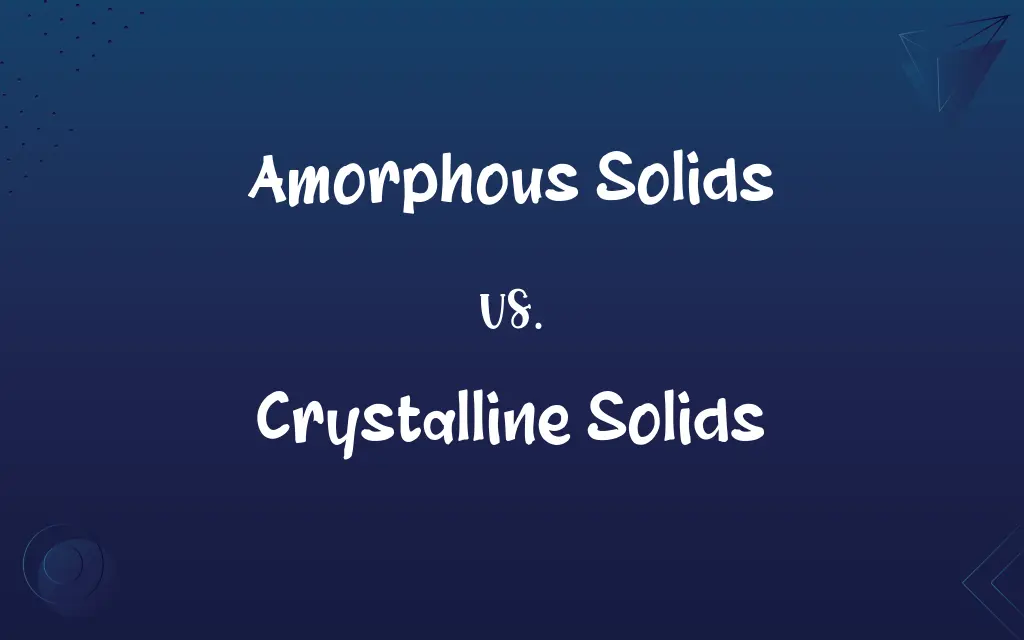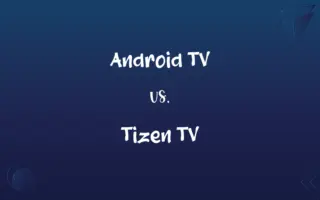Amorphous Solids vs. Crystalline Solids: Know the Difference

By Shumaila Saeed || Updated on December 25, 2023
Amorphous solids have disordered atomic arrangements, while crystalline solids feature orderly, repeating patterns.

Key Differences
Amorphous solids are characterized by a lack of long-range order in their atomic or molecular structures. In contrast, crystalline solids exhibit a highly ordered arrangement of atoms or molecules extending over long distances. This fundamental difference in internal structure leads to distinct physical properties.
Shumaila Saeed
Dec 24, 2023
In amorphous solids, the atoms or molecules are arranged randomly, which results in a lack of sharp melting points. Crystalline solids, on the other hand, have a regular lattice structure, leading to sharp melting points. This distinction is crucial in understanding the thermal behaviors of these materials.
Shumaila Saeed
Dec 24, 2023
Optical properties also differ significantly; amorphous solids typically show isotropic behavior, meaning their properties are the same in all directions. Conversely, crystalline solids are anisotropic, exhibiting varying properties in different directions due to their ordered structure.
Shumaila Saeed
Dec 24, 2023
When it comes to mechanical strength, amorphous solids usually demonstrate a more flexible and ductile nature. Crystalline solids, with their rigid lattice structure, often show higher degrees of brittleness.
Shumaila Saeed
Dec 24, 2023
Electrical conductivity is another area of difference. Amorphous solids generally have lower conductivity and can sometimes be insulators, while crystalline solids often have higher conductivity, with some forming excellent conductors or semiconductors.
Shumaila Saeed
Dec 24, 2023
ADVERTISEMENT
Comparison Chart
ADVERTISEMENT
Amorphous Solids and Crystalline Solids Definitions
Amorphous Solids
Amorphous solids lack a definite crystalline structure.
Glass is an amorphous solid, not crystallizing even upon cooling.
Shumaila Saeed
Dec 09, 2023
Crystalline Solids
Crystalline solids are anisotropic.
In quartz, a crystalline solid, the electrical properties vary with direction.
Shumaila Saeed
Dec 09, 2023
Amorphous Solids
Amorphous solids have atoms arranged randomly.
Rubber, an amorphous solid, can stretch due to its random molecular arrangement.
Shumaila Saeed
Dec 09, 2023
Crystalline Solids
Crystalline solids exhibit long-range order.
Diamonds, crystalline in nature, show a consistent atomic pattern throughout.
Shumaila Saeed
Dec 09, 2023
Amorphous Solids
Amorphous solids do not have a sharp melting point.
Plastic, an amorphous solid, softens over a range of temperatures instead of melting at a specific point.
Shumaila Saeed
Dec 09, 2023
ADVERTISEMENT
Crystalline Solids
Crystalline solids have sharp melting points.
Ice, a crystalline solid, melts sharply at 0°C.
Shumaila Saeed
Dec 09, 2023
Amorphous Solids
Amorphous solids have a short-range order.
Amorphous silica exhibits only short-range order in its silicon-oxygen network.
Shumaila Saeed
Dec 09, 2023
Crystalline Solids
Crystalline solids can conduct electricity.
Copper, a crystalline solid, is an excellent conductor of electricity.
Shumaila Saeed
Dec 09, 2023
Amorphous Solids
Amorphous solids are isotropic in nature.
In amorphous solids like wax, properties like refractive index are the same in all directions.
Shumaila Saeed
Dec 09, 2023
Crystalline Solids
Crystalline solids have a regular and repeating pattern of atoms.
Salt crystals form a regular lattice, characteristic of crystalline solids.
Shumaila Saeed
Dec 09, 2023
Repeatedly Asked Queries
Can crystalline solids be isotropic?
Generally, crystalline solids are anisotropic due to their ordered structure.
Shumaila Saeed
Dec 24, 2023
What defines an amorphous solid?
Amorphous solids are characterized by a disordered atomic arrangement and lack long-range order.
Shumaila Saeed
Dec 24, 2023
Are amorphous solids isotropic or anisotropic?
Amorphous solids are isotropic, with uniform properties in all directions.
Shumaila Saeed
Dec 24, 2023
Do amorphous solids have well-defined lattice parameters like crystalline solids?
No, amorphous solids do not have well-defined lattice parameters since they lack a regular lattice structure.
Shumaila Saeed
Dec 24, 2023
How do amorphous solids differ in melting point from crystalline solids?
Amorphous solids have broad or undefined melting points, while crystalline solids melt sharply at specific temperatures.
Shumaila Saeed
Dec 24, 2023
Do crystalline solids have a distinct melting point?
Yes, crystalline solids have a well-defined melting point at which they change from a solid to a liquid state.
Shumaila Saeed
Dec 24, 2023
What are examples of crystalline solids?
Examples include salt (sodium chloride), diamonds, and quartz.
Shumaila Saeed
Dec 24, 2023
What is a crystalline solid?
Crystalline solids have an ordered, repeating atomic or molecular structure across long distances.
Shumaila Saeed
Dec 24, 2023
Which type of solid is typically transparent, amorphous or crystalline?
Crystalline solids are often transparent, while amorphous solids can be either transparent or opaque.
Shumaila Saeed
Dec 24, 2023
Are amorphous solids more flexible than crystalline solids?
Yes, amorphous solids tend to be more flexible and have less rigidity compared to crystalline solids.
Shumaila Saeed
Dec 24, 2023
Do amorphous solids have a distinct melting point?
Amorphous solids typically have a range of softening temperatures rather than a distinct melting point.
Shumaila Saeed
Dec 24, 2023
What is an amorphous solid?
An amorphous solid is a type of solid material that lacks a regular, repeating atomic or molecular structure.
Shumaila Saeed
Dec 24, 2023
Give examples of amorphous solids.
Examples include glass, plastic, and some types of rubber.
Shumaila Saeed
Dec 24, 2023
What is the main difference between amorphous and crystalline solids?
The key difference is the arrangement of particles: amorphous solids lack a regular structure, while crystalline solids have a highly ordered structure.
Shumaila Saeed
Dec 24, 2023
Which type of solid is used in the production of window glass, amorphous or crystalline?
Window glass is typically made from amorphous solids, such as soda-lime glass.
Shumaila Saeed
Dec 24, 2023
Do crystalline solids exhibit anisotropy or isotropy?
Crystalline solids are anisotropic, meaning their properties can vary with direction.
Shumaila Saeed
Dec 24, 2023
Can crystalline solids have defects in their structure?
Yes, crystalline solids can have defects such as vacancies, dislocations, or impurities in their crystal lattice.
Shumaila Saeed
Dec 24, 2023
Are amorphous solids transparent or opaque?
Amorphous solids can be transparent or opaque, depending on their composition.
Shumaila Saeed
Dec 24, 2023
Share this page
Link for your blog / website
HTML
Link to share via messenger
About Author
Written by
Shumaila SaeedShumaila Saeed, an expert content creator with 6 years of experience, specializes in distilling complex topics into easily digestible comparisons, shining a light on the nuances that both inform and educate readers with clarity and accuracy.








































































